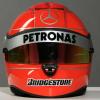
Driving Position- F1 vs tin-top
#1

Posted 25 August 2007 - 20:55
Anyone have a clue as to the advantage of that driving postion compared to open wheel cars. I race a spec Miata and couldn't imagine sitting that close to the wheel...
Advertisement
#2

Posted 25 August 2007 - 21:08
Originally posted by SKL
Actually watched the NASCAR race at Watkins Glen (HD made me wish Speed had that for F1) and can't figure out why those guys sit so CLOSE to the steering wheel. Can't imagine JPM can get comfortable sitting so upright and close to the wheel with his arms bent so much. And on a road course to boot...
Anyone have a clue as to the advantage of that driving postion compared to open wheel cars. I race a spec Miata and couldn't imagine sitting that close to the wheel...
I think it has to do with driving a very heavy car on an oval. In nascar it is not neccesary to make many 'round' steerings, more tiny, very heavy steerings. Holding the steering steady on small movements could explain the sitting position.
#3

Posted 25 August 2007 - 21:19
Have you seen Rally drivers? They also have the steer really near the body.Originally posted by Jerome.Inen
I think it has to do with driving a very heavy car on an oval. In nascar it is not neccesary to make many 'round' steerings, more tiny, very heavy steerings. Holding the steering steady on small movements could explain the sitting position.
Probably you have to consider the opposite. The F1 drivers have the arms extended because they don't have place for more.
#4

Posted 26 August 2007 - 02:08
-The car is harder to steer than a Formula car. Heavier and not as unstable/twitchy as F1. F1 cars have plenty of power/electrical steering.
-You are going to hit other cars or walls every race. You usually don't do this in an F1 car...unless Michael Schumacher is on the track.
-The NASCAR races are usually quite a bit longer. More fatigue.
So use a bigger diameter wheel and use your shoulders more, without the arms extended.
#5

Posted 26 August 2007 - 02:33
I have had a few defensive driving lessons and lesson one was placing the seat, and we where supposed to be able to cross our elbows (having a full 360 degrees sweep, 180 each side) without releasing the wheel. It seemed too close at first but made all the sense when doing some slalom later on.
#6

Posted 26 August 2007 - 03:16
#7

Posted 26 August 2007 - 05:01
I had a quick punt through the gallery, but I couldn't find anything conclusive. I'll keep looking.
Richard
#8

Posted 26 August 2007 - 08:06
#9

Posted 26 August 2007 - 08:25
1) With power steering, full lock is less than half a turn of the wheel as with a Kart, this means,
2) You can have a shorter cockpit, reducing the level of turbulence in that area.
3) That the cockpit area being shorter can help to maximise the area available for aerodynamics below and behind the front "Axle" line.
4) The shorter the front to back area of the car the driver fills, the shorter the wheelbase can be, or the further back the aerodynamic fripperies under the front can stretch, or a combination of both.
Driver comfort is, of course, of no relevance at all!
#11

Posted 26 August 2007 - 09:47
Originally posted by TailG
Maybe it just seems like NASCAR drivers are closer to the wheel because they are so overweight?
you'd think if that was the case they'd sit further away ;)
nah, nascar has always used that seating position from the pre-power steering days because steering then becomes/became arms and shoulders strength rather than using the arms straight-out and therefore not being able to 'pull' on the wheel. Bear in mind there's no benefit to sitting lower in a nascar anyway, aside of the negligible CofG change, but steering thru long strength-sapping turns up to 1000 times in a race and you'll sit as close to the wheel as you can
#12

Posted 26 August 2007 - 10:52

#13

Posted 26 August 2007 - 18:05
#14

Posted 26 August 2007 - 18:43
This position started to change as wings came in. Front ends became "heavier and heavier", engines went to 3L, and cars got bigger and stronger to cope with the forces. Gradually evolved to what we see today and has more to do with safety and protecting a drivers head.
Pretty much all seat postures are the same nowadays - no matter the series - elbows about 90 degrees in a straight ahead position, knees about 45, back somewhere between 50-70 degrees. The drivers position has less effect on aero these days - because air is directed around the cockpit. Now, they shape the helmets to maximize air into the engine intake and to reduce lift on the driver's head.
#15

Posted 26 August 2007 - 22:03
Originally posted by JSDSKI
The "laid back" arms fully extended whilst controlling the steering wheels with your fingers was created by Chapman at Lotus and was used to reduce cross section and drag. It reached it's peak in the middle sixties with Clark and the Lotus 25. It was only possible because those F1 cars were 1.5L tiny lightweight darts and pretty easy to control.
This position started to change as wings came in. Front ends became "heavier and heavier", engines went to 3L, and cars got bigger and stronger to cope with the forces. Gradually evolved to what we see today and has more to do with safety and protecting a drivers head.
Pretty much all seat postures are the same nowadays - no matter the series - elbows about 90 degrees in a straight ahead position, knees about 45, back somewhere between 50-70 degrees. The drivers position has less effect on aero these days - because air is directed around the cockpit. Now, they shape the helmets to maximize air into the engine intake and to reduce lift on the driver's head.
Funny, the Cooper* I drove had exactly that position..................
*It wasn't mine I hasten to add.
#16

Posted 26 August 2007 - 22:17
You should post some pix
#17

Posted 26 August 2007 - 22:20
#18

Posted 26 August 2007 - 22:23
Originally posted by pkrash
There are a few reasons:
-The car is harder to steer than a Formula car. Heavier and not as unstable/twitchy as F1. F1 cars have plenty of power/electrical steering.
F1 cars have far heavier steering, especially at high speeds. That´s according to Juan Montoya, who has tested both. The same applies to pedals. That´s according to Jeff Gordon, who has tested both.
-You are going to hit other cars or walls every race. You usually don't do this in an F1 car...unless Michael Schumacher is on the track.
Nothing to do with seating position, though.
-The NASCAR races are usually quite a bit longer. More fatigue.
Less. The cars are nowhere as physical to drive, and while you have longer races, yellows and numerous pitstops give the drivers more opportunities to rest. There are reasons why many (certainly not all!) of the NASCAR drivers are "old" and "fat", but still handle the toughest races without too many problems.
#19

Posted 26 August 2007 - 22:25
Originally posted by jb_128
I'd say nascar is indeed a lot closer than the others, but they are all closer than your average road car driver.
...who sits too far from the steering wheel, anyway
Advertisement
#20

Posted 26 August 2007 - 23:33
This is because on an oval the adjustments required to the steering wheels of the car are so precise given the rarified nature of the circuit. That huge wheel actually controls only a very small amount of steering travel (even compared to the small lock of an F1 car) so the size and position of the wheel is much more conducive to control in that environment.
Of course this is where all the morons leap up and down and claim that no way on earth could the "touch" required in Nascar be greater than that required in F1 . . .
#21

Posted 27 August 2007 - 09:18
Originally posted by BorderReiver
The reason NASCAR drivers sit so close is because the wheel is relativly larger and the steering ratio vastly so. A large movement on a NASCAR ratio produces a small movement of the tyres relative to the same movement in F1 would have you zipping across the track like a nutcase.
Yep
#22

Posted 27 August 2007 - 20:21
Originally posted by JSDSKI
Wonderful to hear of your personal experience. How old was the Cooper? Seems to me the one Brabham drove ('59 '60 ??) had a more upright position than the Lotus 18. Of course, my experience is observational.
You should post some pix

It was a Formula Junior car converted for Hill Climb use by Barry Lane, then to F3 for the 1964 season; a similar one driven by Mike Budge held the Brands Hatch F3 lap record for a while.
Me sitting in it, I was still playing prop for Harlequins at the time, as you can see, I was a tight fit, the seat being positioned for someone 4 stone lighter and 3" shorter! As you can see from the trailer, what little money Paul had was spent on the Cooper. The tow car was borrowed from his Mother, and it parted company with the trailer on the way to Silverstone; fortunately, after the trailer, complete with Cooper, had finished careering down the road, it was our good fortune that it made a bee-line for a pile of grit on the grass verge, a relatively soft landing. We roped the trailer to the back bumper of the Humber Super Snipe, and carried on. Paul managed 2nd place behind the brand new F3 Alexis, so all was well that ended well................

#23

Posted 27 August 2007 - 21:46
Originally posted by SKL
Can't imagine JPM can get comfortable sitting so upright and close to the wheel with his arms bent so much.
for some reason I imagened him eating hamburguers....
#24

Posted 27 August 2007 - 22:33
Originally posted by Bloggsworth It was a Formula Junior car converted for Hill Climb use by Barry Lane, then to F3 for the 1964 season; a similar one driven by Mike Budge held the Brands Hatch F3 lap record for a while.

Excellent pix and a wonderful story. Looks like it's, what a '61 or '62? Great car. I wonder how many of us here have those kinds of experiences just waiting to be brought out. I've also had the delightful experience of watching one's pride and joy whistle past on a cheap trailer. Snapped the rear bumper and stays off a VW panel van driving too fast over a bump in Albuquerque NM very late one winter night. Ran past me in a shower of sparks. Straight as an arrow - luckily. Thought it was a UFO or a motorcycle crash until I realized that was my Porsche on a trailer
#25

Posted 28 August 2007 - 07:59
Originally posted by Bloggsworth
It was a Formula Junior car converted for Hill Climb use by Barry Lane, then to F3 for the 1964 season; a similar one driven by Mike Budge held the Brands Hatch F3 lap record for a while.
Me sitting in it, I was still playing prop for Harlequins at the time, as you can see, I was a tight fit, the seat being positioned for someone 4 stone lighter and 3" shorter! As you can see from the trailer, what little money Paul had was spent on the Cooper. The tow car was borrowed from his Mother, and it parted company with the trailer on the way to Silverstone; fortunately, after the trailer, complete with Cooper, had finished careering down the road, it was our good fortune that it made a bee-line for a pile of grit on the grass verge, a relatively soft landing. We roped the trailer to the back bumper of the Humber Super Snipe, and carried on. Paul managed 2nd place behind the brand new F3 Alexis, so all was well that ended well................
great story! don't you just love how nimble cars were back then.....
#26

Posted 28 August 2007 - 09:04
#27

Posted 29 August 2007 - 21:37

Don't know if it's of any interest.
#28

Posted 29 August 2007 - 21:51
#29

Posted 29 August 2007 - 23:47
#30

Posted 31 August 2007 - 13:35
Originally posted by JSDSKI
The "laid back" arms fully extended whilst controlling the steering wheels with your fingers was created by Chapman at Lotus and was used to reduce cross section and drag. It reached it's peak in the middle sixties with Clark and the Lotus 25. It was only possible because those F1 cars were 1.5L tiny lightweight darts and pretty easy to control.
just went looking for pics and found this one: http://upload.wikime...tus19620805.jpg
and here's another of clark: http://www.jsolana.c...lotos/clark.jpg
#31

Posted 31 August 2007 - 14:12
#32

Posted 31 August 2007 - 14:27
#33

Posted 31 August 2007 - 15:42
I was about to jump all over that post, but decided not to. It just gripes me how often people comfortably state, so matter of factly, opinions that are dead wrong!
I also think it's NASCAR stipulated tradition to keep the large diameter steering wheel, even if the cars have been using power steering for a long time now. Same for leaded gasoline (!!), etc. They're hell bent on keeping things unchanged, even at the expense of safety. That's the only positive to come out of Earnhardt's death!
Border: They use the same steering wheels on the road courses too, it really has little to do with touch, or oval racing or anything of the sort.
#34

Posted 31 August 2007 - 15:55
Originally posted by Hacklerf
I had a go in an F1 simulator and found it extremely comfortable, my hand positions were directly above my balls.
Did you start from scratch?
#35

Posted 31 August 2007 - 16:02
#36

Posted 31 August 2007 - 17:24
Originally posted by BMW4life
Border: They use the same steering wheels on the road courses too, it really has little to do with touch, or oval racing or anything of the sort.
They use entirely different steering ratio's though. For fine adjustments on an oval you want a big wheel, not a tea-saucer (it makes me feel sorry for the IRL and the other opened wheeler series who have to deal with just as much, if not more fine work and have to do it with a diddy little finicky wheel making it all arms and elbows).
The useful lock on a superspeedway for example can translate to a handful of degrees of travel with the tyres. Obviously on road courses they rack this up massivley as the car has do deal with all manner of turns, but a large wheel helps massivly in the former scenario. Traditional it may be, but it also works extremely well for the category. In an enviroment where so many small corrections and movements are necessary it makes sense to have as large a control device as possible to make the business easier . . .



























